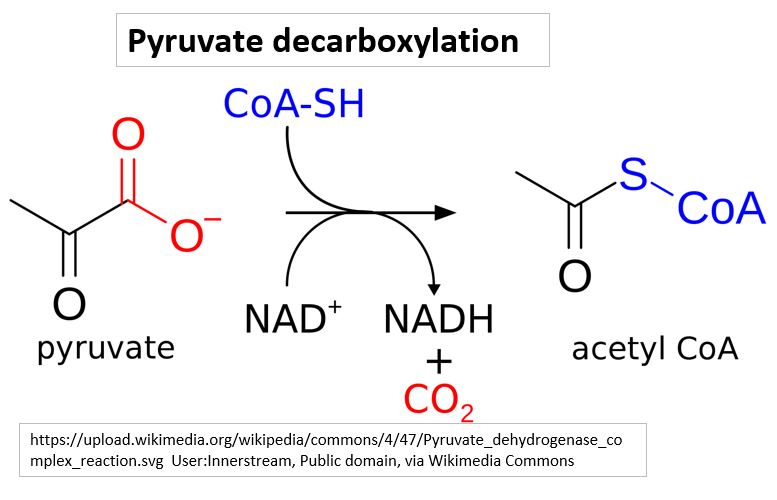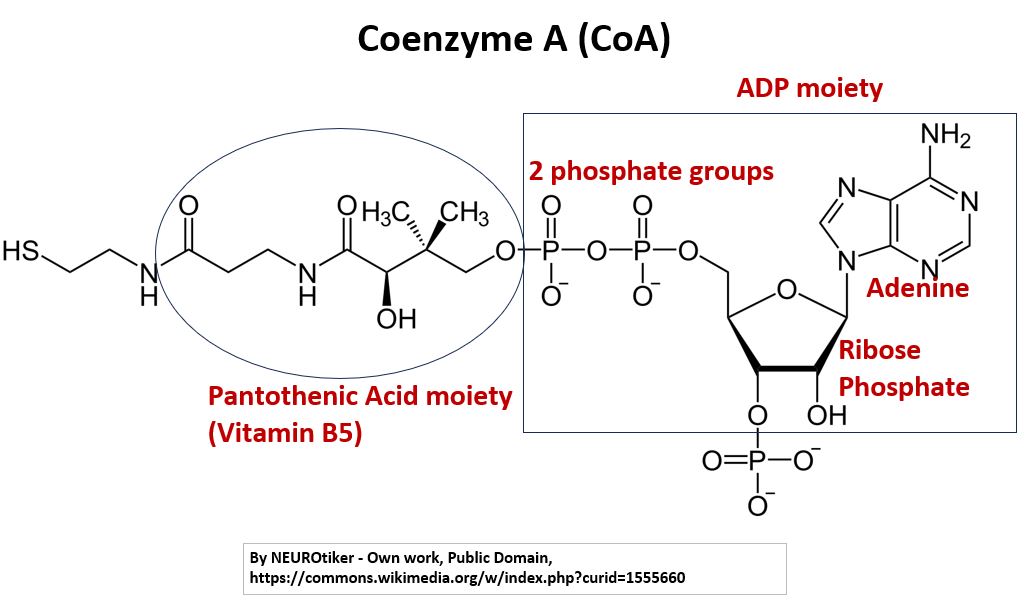Menu (linked Index)
Cellular Respiration (III) Pyruvate to Acetyl CoA
Last Update: October 29, 2024
Introduction
This is part III of a 5 part series on Cellular Respiration. You can access the other posts via the links below.
- Cellular Respiration (I) Overview
- Cellular Respiration (II) Glycolysis
- Cellular Respiration (III) Pyruvate to Acetyl CoA
- Cellular Respiration (IV) Krebs Cycle
- Cellular Respiration (V) Oxidative Phosphorylation
In what is often called the Transition Step of Cellular Respiration, Pyruvate produced by Glycolysis is converted to Acetyl CoA (or Acetyl Coenzyme A).
In this post we’ll describe the reaction and dwell a little on the amazing molecule, Acetyl Coenzyme A.
Pyruvate to Acetyl CoA Reaction
So a 6 carbon sugar (glucose) is glycolyzed or split into 2 Pyruvates.
This happens in the cytoplasm of most of our cells.
Pyruvate then travels from the cytoplasm into the inner sections (matrix) of the mitochondria where it reacts with Coenzyme A to form Acetyl CoA.
Picture_Pyruvate Decarboxylation (Oxidation)

- Each Pyruvate (there will be two for each Glucose) loses a carbon (and two oxygens to form CO2) , and
- will attach to the Coenzyme A forming Acetyl CoA.
- Another NADH is also produced as NAD+ is reduced to NADH.
Coenzyme A (CoA)
We have to take a closer look at Coenzyme A (aka CoA , aka CoA-SH).
Picture_Coenzyme A (CoA or CoA-SH)

So, CoA has an ADP group or moiety (a nucleotide) and a Vitamin B5 moiety.
Have you seen some of these chemical groups before? You should be understanding by now that
- these adenine, ribose, and phosphate groups (or similar groups) are contained in some of our body’s most important chemicals (DNA, RNA, ATP, NADH, etc.) and
- vitamins play a crucial role in our metabolism.
CoA is a crucial coenzyme that plays a central role in various metabolic functions in your body.
- It delivers the Acetyl group to the Krebs cycle where it reacts with an intermediate to begin/repeat the Krebs Cycle.
- CoA also is involved in the production of a crucial Krebs cycle intermediate
- CoA pays a role in other metabolic pathways as well (e.g. biosynthesis involving Fatty Acids and Amino Acids etc. )
Your body has to make CoA , and one of its main building blocks is Pantothenic Acid (Vitamin B5).
- Our bodies cannot manufacture Vitamin B5 ; we have to get it from out diet.
Realize that Vitamins are very important to your well being (are you getting enough ?).
Acetyl Coenzyme A (Acetyl CoA)
Acetyl CoA is one of your body’s rock-star molecules.
We have focused on Acetyl CoA from carbohydrates (glucose) , but it can also come from fats or proteins.
In addition to the Krebs cycle, this molecule is used as a building block in many other reactions.
By donating its acetyl group it is involved in the synthesis of :
- Fatty acids (to make fat for energy storage, phospholipids {in cell membranes}, Neuron Myelin etc.).
- Cholesterol (to make Vitamin D, Steroid Hormones, Bile Sales, membranes, etc.).
- Ketone bodies (used by the brain and muscle as an alternative fuel source).
But, let’s continue with our stages of Cellular Respiration.
After the Pyruvates make their way to the mitochondrial matrix and get converted to Acetyl CoA, Stage 3 of cellular respiration can begin (the Krebs Cycle).
Conclusion
In this post we learned about Stage 2 of Cellular Respiration, the Transition Step,
- where 2 Pyruvates (produced for each Glucose) are converted to 2 Acetyl CoA molecules and where
- 2 NADHs and 2 CO2s are also produced.
Acetyl CoA is a versatile Nucleotide containing molecule:
- It delivers an Acetyl group to the 3rd Stage of of Cellular Respiration, the Krebs Cycle.
- Acetyl CoA also plays a role in other metabolic pathways (e.g. biosynthesis involving Fatty Acids and Amino Acids etc. )
The next stage of Cellular Respiration is the Krebs Cycle and you can read my article on it via the link below.
Disclaimer: The content of this article is intended for general informational and recreational purposes only and is not a substitute for professional “advice”. We are not responsible for your decisions and actions. Refer to our Disclaimer Page.
